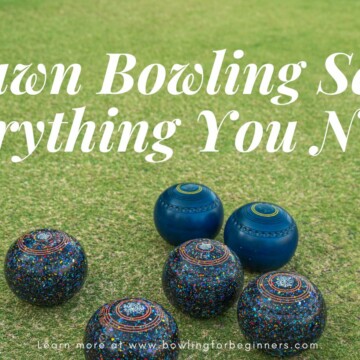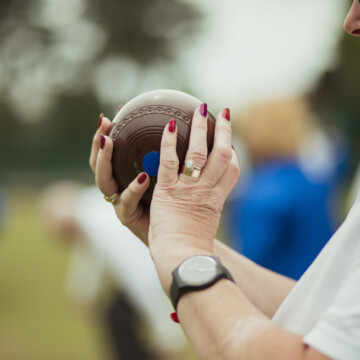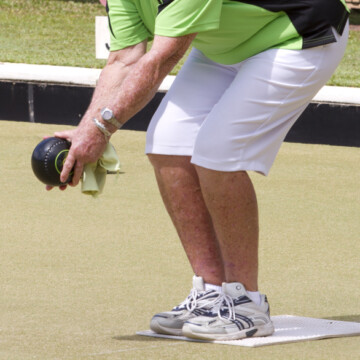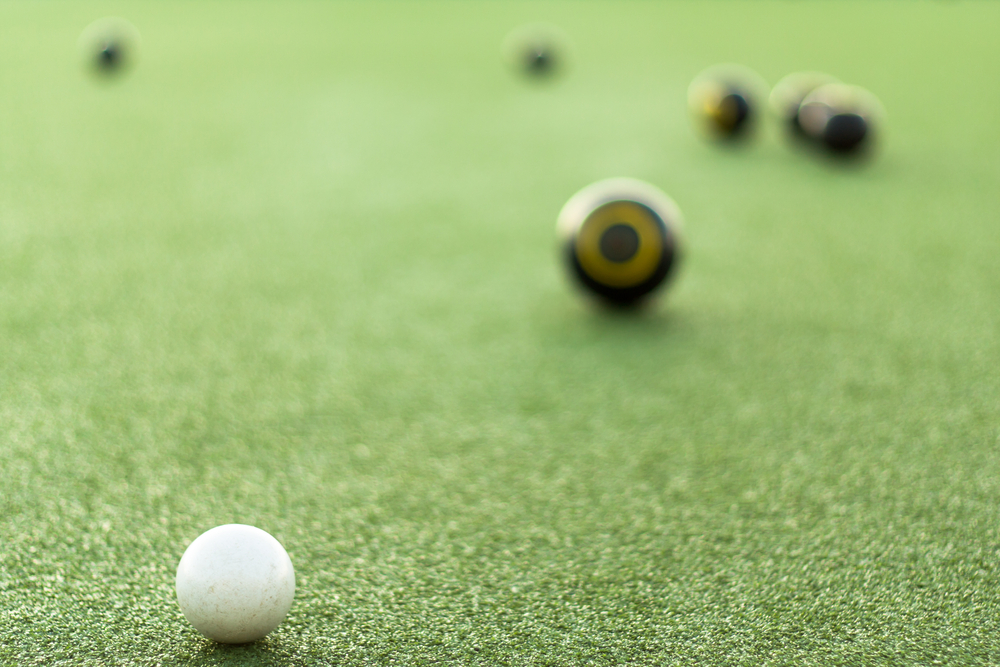
Are you just getting into lawn bowling? It’s a whole new world, much different from traditional bowling. Before you step onto the green for a lawn bowling game, you'll need to acquaint yourself with the unsung hero of the game: the lawn bowling ball.
It’s much more than a simple ball; this specially designed piece of equipment can make or break your game. In this article, we’ll delve into what makes these balls unique and answer any related questions you might have.
Contents
- 1 What Is a Lawn Bowling Ball?
- 2 Characteristics of Lawn Bowling Ball’s Design
- 3 The Jack (Kitty or Target Ball)
- 4 How To Play Lawn Bowls
- 5 What’s in a Lawn Bowling Set?
- 6 Other Lawn Bowling Balls
- 7 What Is a Lawn Bowling Ball Called?
- 8 Is Lawn Bowling the Same as Bocce Ball?
- 9 How Do I Know What Size Lawn Bowl to Buy?
- 10 What Is the Difference Between Crown Green Bowls and Lawn Bowls?
- 11 Lawn bowling balls for sale? Which are the best and where to buy them?
- 12 Related Articles
What Is a Lawn Bowling Ball?
Lawn bowling balls are the key piece of equipment in the sport of lawn bowls or lawn bowling. Unlike regular bowling balls, which are large, spherical, and have finger holes, these are not perfect spheres and don't have holes. They're also small and designed with a bias, meaning one side is flatter than the other.
This bias causes the ball to travel in a curved path rather than a straight line. The sport is often played outdoors on a flat green made of natural grass or artificial turf. To learn more about the rules of lawn bowling, read this article.
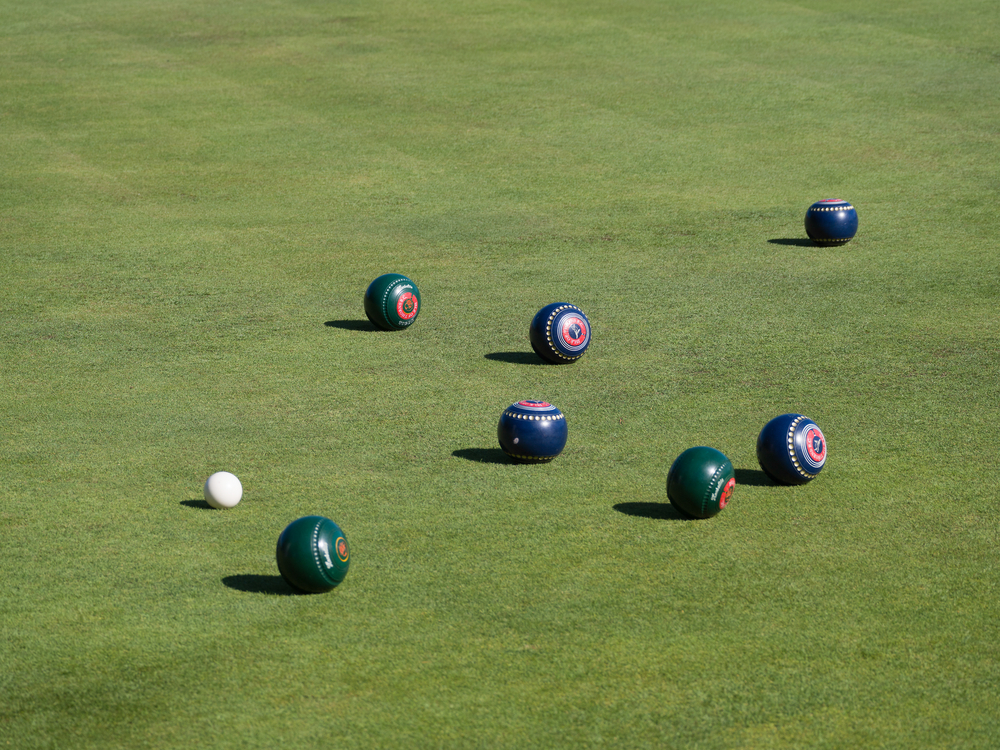
Characteristics of Lawn Bowling Ball’s Design
You’ve got the basics down - now, let’s look at the lawn bowling ball’s design in a little more detail. Keep reading to learn about the most important aspects of the ball’s design and what that means for your game.
Bias
Perhaps the most critical aspect and distinctive feature is the bias. Bias is the uneven distribution of weight within the bowl, causing it to curve or "swing" as it rolls. Lawn bowls are not perfect spheres; one side is designed to be slightly flatter than the other, causing the bowl to curve after delivery.
This bias allows players to navigate around other bowls and obstacles to get closer to the jack. Players need to account for this bias when aiming, often requiring them to aim away from their intended target, the jack, to account for the curve to come.
Material
Modern bowls are primarily made from a hard plastic composite material like phenolic resin or melamine, although you can still find traditional wooden bowls if you search hard enough. The choice of material influences the bowl's weight, balance, and durability.
Composite materials often provide a more consistent performance across different weather conditions, which is critical in a sport typically played outdoors. Wooden bowls, although charming, can be affected by moisture and temperature, leading to inconsistent play.
Size and Weight
Bowls come in various sizes and weights, usually ranging from heavy to light. The weight affects how far the bowl can travel and how much effort is needed to propel it, impacting the physical exertion needed by the player. Size, on the other hand, influences grip and control. A bowl that is too big or too small for a player's hand can lead to overcompensation and inaccurate shots.
Grip
Bowls are typically spherical, but many come with a flattened side called a Peg. The peg helps players identify the bias and maintain a consistent grip. Grips, indentations, or patterns on the surface of the ball helps to improve the player's hold.
A few of the most common lawn bowling ball grips include dimples, crescents, and embedded grips. These grips are useful whether a bowler is a left or right handed bowler. Each grip will feel a little different from the next and affect how the bowl is delivered.
Releasing the ball too early or too late can result in a shot that misses your target. The type of grip you ultimately choose should feel comfortable to you and aid you in finding your stride on the green. Practice the following shots to see if you like a certain grip:
- Forehand draw
- Backhand draw
- Yard-on Shot
- Running Shot
Color and Markings
Bowls come in various colors, with common colors being black, brown, and shades of green. While color might seem purely aesthetic, it can have practical implications. Light-colored bowls can be easier to spot in low light conditions but may be affected by glare on sunny days.
Conversely, dark bowls may absorb heat, slightly affecting the bias over extended play. They often feature markings to indicate their size, bias, and manufacturer.
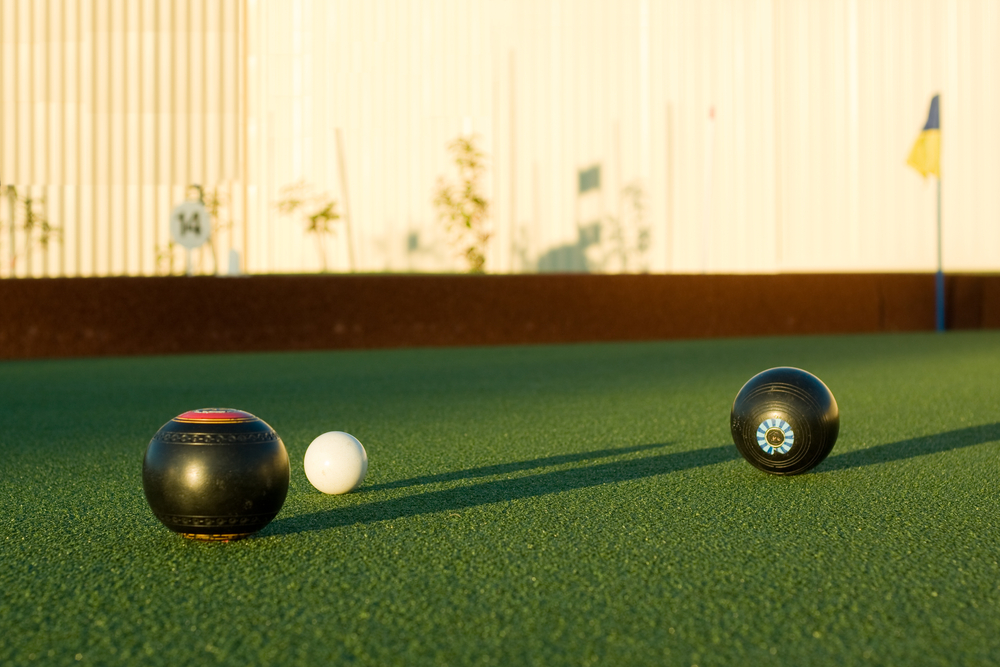
The Jack (Kitty or Target Ball)
The jack (kitty or target ball) is usually made of a solid, durable material like plastic or hardwood and is totally spherical in shape. The jack is thrown first to set the objective for the game, and its position becomes the focal point around which players aim their larger, biased bowls.
The placement of the jack can dramatically impact the difficulty of each player's subsequent shots and the strategies they employ.
How To Play Lawn Bowls
Played on either natural grass, an outdoor surface, or artificial turf, the primary objective in lawn bowls is to get your team's bowls closer to the jack than the opposing team's bowls. The team that has the bowl(s) closest to the jack at the end of a predetermined number of ends (rounds) or when a specific score is reached wins the game.
Lawn bowls can be played in singles (one player per team), pairs (two players per team), triples (three players per team), or fours (four players per team). Within their rink, where the lawn is divided into parallel playing strips, players take turns delivering their bowls from one end of the green, known as the "mat," toward the jack at the opposite end, staying within the rink boundary.
Players must keep one foot on or behind the mat during delivery. Scoring in lawn bowls is based on the proximity of the bowls to the jack. Only one team scores per end, and they receive one point for each bowl closer to the jack than the opposing team's closest bowl.
An end is complete when all players have delivered their bowls. Players then walk to the opposite end of the green and play in the opposite direction. A game consists of a predetermined number of ends, typically between 15 and 21.
Lawn bowls require strategic placement of bowls to protect your team's position and to hinder the opposition. Players aim to either draw close to the jack or knock their opponent's bowls out of contention while avoiding penalties, such as touching the jack. The team with the most points at the end of the predetermined number of ends wins the game.
Lawn bowls is a sport that combines physical skill, precision, and strategic thinking. The design of the bowls, with their bias and various characteristics, plays a crucial role in a player's ability to achieve success on the green.
What’s in a Lawn Bowling Set?
In any lawn bowling ball set, you have 4 larger balls (described above) and a small ball called the jack. Unlike the biased, larger bowls designed for strategic curving and positioning, the jack serves as a target. In addition to the bowls and jack, a few other items may be included in the set, including:
- Carrying bag
- Measure (to determine who's thrown their bowl closer to the jack).
- Chalk spray
Other Lawn Bowling Balls
In addition to the lawn bowl sets we mentioned above, there are lawn bowling sets designed to emulate the experience of traditional ten-pin bowling but in an outdoor setting like your backyard. These sets offer a fun and casual way to enjoy the game without having to head to an actual bowling alley.
Material
The bowling balls in these sets are typically made of a lighter material like plastic or rubber. They are designed for easy gripping and rolling but won't usually have the finger holes you'd find in a traditional bowling ball. The aim is to make the set accessible and safe, especially for kids or casual players.
Gameplay
The gameplay for this variation of lawn bowling is pretty much what you'd expect from traditional bowling, just scaled down and modified for outdoor play. The objective is to knock down the pins by rolling the ball along the ground.
You can choose a simplified scoring system or go with traditional lawn bowling rules, depending on how serious you want to get (first to seven points, first to 21 points, etc.). You can also decide on the game structure - whether you want to play a singles game, a singles competition, or a doubles match.
Setup
These sets are generally easy to set up and take down, making them great for spontaneous games or parties. They're also highly portable; you can pack them up for a day at the park or a beach outing. And if you want, you can also bring them to indoor venues.
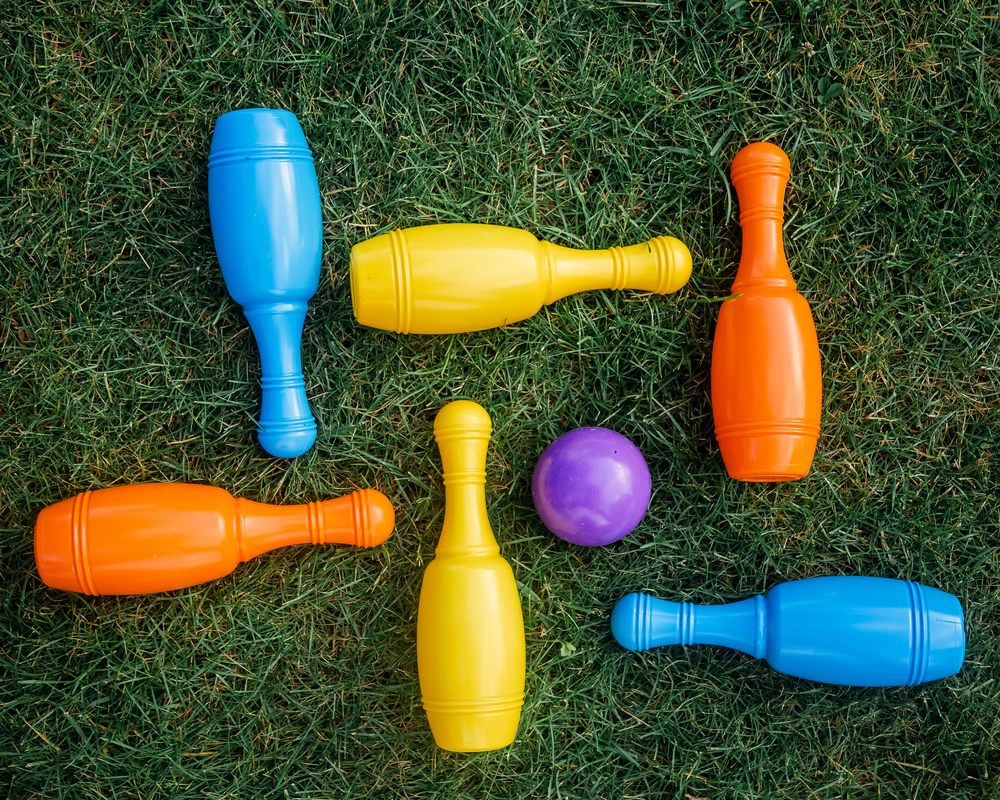
Tra Bowls
Tra Bowls (hollow road) or Feather Bowling is a variation of lawn bowling from western Belgium/Netherland and Scandinavian communities. The twist is Tra Bowls or Feather bowling has a rolling path that is concaved or curved and hollow in the center instead of flat, like Lawn Bowling.
The target is a feather! The feather (or heavy plate) is permanently located and unmovable during gameplay. The bowls are biased but are much bigger than typical lawn bowls. The game's object is to get as close to the feather as possible.
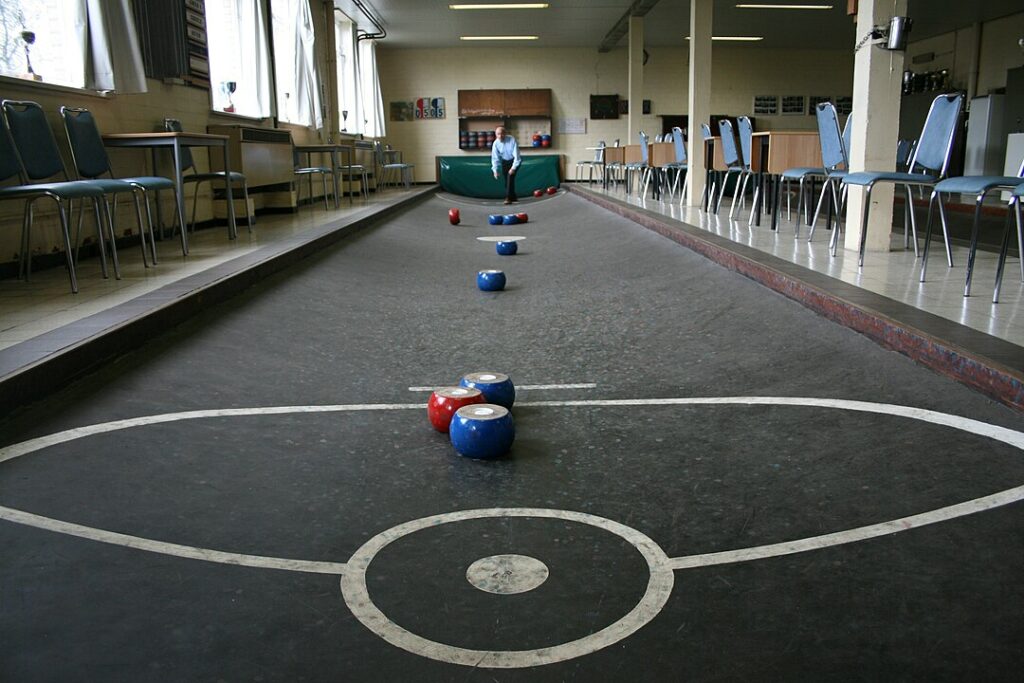
What Is a Lawn Bowling Ball Called?
The balls used in lawn bowling are commonly called "bowls” or “lawn bowls." Recall that these balls are designed with a bias, making one side slightly flatter than the other. They aren’t like traditional bowling balls as we know them.
So, even though they may look somewhat similar to regular balls at first glance, calling them "bowls" or “lawn bowls” aligns with the sport's terminology and distinguishes them by their unique design and role in this tactical game.
Is Lawn Bowling the Same as Bocce Ball?
Lawn bowling and bocce are often confused, but they're actually 2 different games with different rules, equipment, and strategies. Both are outdoor games where teams bowl alternately to get their balls as close as possible to a smaller target ball - but the similarities mostly end there.
In lawn bowling, the balls, known as "bowls," are asymmetric and designed to curve when rolled. The game is generally played on a flat, rectangular green and involves a fair amount of strategy due to the bowls' bias.
Bocce, on the other hand, uses symmetrical balls that roll in a straight line and are usually played on a variety of outdoor surfaces, including natural grass and sand. While both games aim to get close to a target, the way you get there is quite different in each sport.
Read this comprehensive guide to learn more about lawn bowling and bocce ball differences.
How Do I Know What Size Lawn Bowl to Buy?
Choosing the correct sized lawn bowls is a blend of hand size, strength, playing style, and personal comfort. We urge you to start by gripping various sample bowls to see what fits comfortably in your hand.
And since your physical condition also plays a role, lighter, smaller bowls might be more manageable if you have limited strength, while a larger, heavier bowl could offer better control if you're stronger.
What Is the Difference Between Crown Green Bowls and Lawn Bowls?
Crown green bowls and flat green lawn bowls are two distinct variations of the bowls family of games, and they have key differences in playing surfaces, bowl design, and rules. Crown Green Bowls is played on a green with a subtle dome shape, hence the term "crown," which adds an extra layer of complexity to the game as the bowls have to navigate varying slopes. Flat green lawn bowls, on the other hand, are played on a flat, rectangular surface.
Lawn bowling balls for sale? Which are the best and where to buy them?
To find lawn bowling balls for sale and determine the best options for your needs, you can follow these steps:
- Local Lawn Bowling Clubs or Brick & Mortar Retailers Near You: Start by checking with your area's local lawn bowling clubs or sports equipment retailers. They may have a selection of lawn bowling balls for sale. Visiting a local club can also help you get advice from experienced bowlers on which balls are suitable for your skill level and playing conditions. So, have an idea in mind about where you intend to play.
- Online Retailers: Numerous online retailers sell lawn bowling balls. Some popular options include Amazon, eBay, and specialized sports equipment websites. You can browse various brands and models online, read customer reviews, and compare prices.
- Bowling Brands: Several reputable brands manufacture lawn bowling balls. Some well-known brands include Henselite, Taylor Bowls, Drakes Pride, and Aero Bowls. All their bowls are offered in various models with different characteristics, such as size, weight, and bias. If you are in the United States, be mindful about where you are ordering from. Many online retailers may ship from different countries. Here are some US lawn bowling ball manufacturers.
- Consider Your Skill Level: When choosing lawn bowling balls, it's essential to consider your skill level and playing style. Beginners may prefer slightly larger and lighter bowls, while experienced bowlers might opt for more specialized options tailored to their preferences.
- Lawn Conditions: The type of lawn or green (crown, flat, indoor carpet) you'll be playing on can also affect your choice of bowls. Talk to experienced bowlers or your local club to understand the green's characteristics and how they should influence your selection.
- Bias: Lawn bowls come in different biases (the curved path they follow). Some have a strong bias, while others have a less pronounced bias. Your choice should align with your playing style and the type of shots you intend to make.
- Cost: Prices for lawn bowling balls can vary significantly based on brand, material, and model. Set a budget and look for options that fit within your price range.
- Warranty and Return Policy: Check the warranty and return policy of the retailer or manufacturer to ensure that you have options if you encounter any issues with your purchased bowls.
- Customer Reviews: Read reviews from other bowlers to get insights into the performance and durability of specific lawn bowling balls.
- Consult with Experienced Bowlers: If you're unsure about which lawn bowling balls to choose, seek advice from experienced bowlers at your local club. They can provide valuable recommendations based on their experience.
Remember that the "best" lawn bowling balls can vary depending on individual preferences, playing style, and the specific conditions of the green. It's a good idea to try out different bowls if possible or consult with experienced bowlers to make an informed decision.
Related Articles
There you have it! Everything you need to know about lawn bowling balls and more. We hope you found all the information you were looking for, and we wish you the best as you explore lawn bowling and other sports you can enjoy outdoors.
Kira Byrd, a Certified Fraud Examiner, holds a B.S. in Accounting from the University of Alabama at Birmingham. With a passion for bowling from her childhood, Kira has poured her expertise and personal experiences into creating and nurturing Bowling For Beginners. Kira's mission is to meet new bowlers where they are and guide them toward consistently achieving higher scores. With a focus on skill development and strategic techniques, she empowers readers to take control of their game and unlock their true potential.
Bowling For Beginners embodies strict editorial integrity, ensuring reliable and unbiased information. Kira's commitment to delivering valuable insights and practical strategies is reflected in every article. Here's an explanation of our editorial policy and how we get money.


